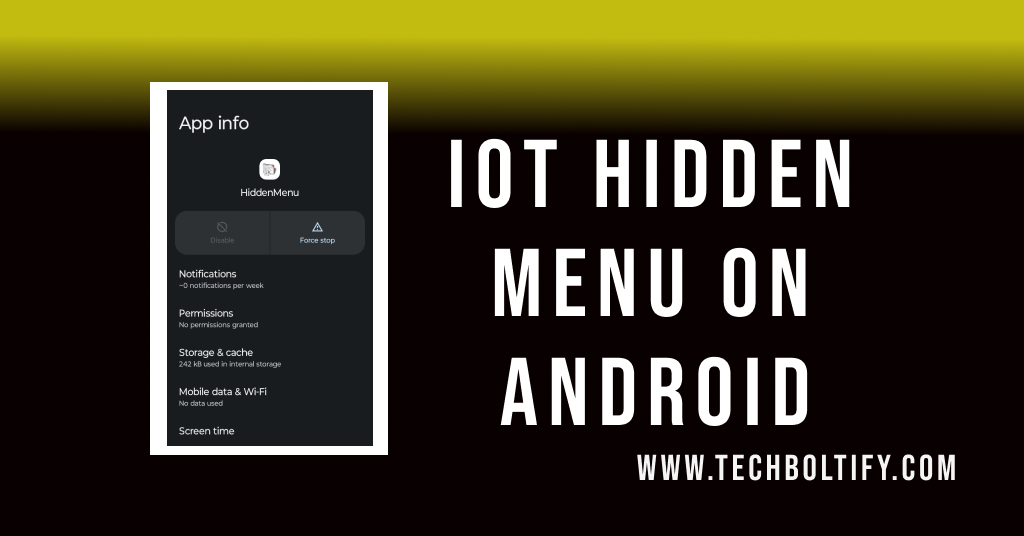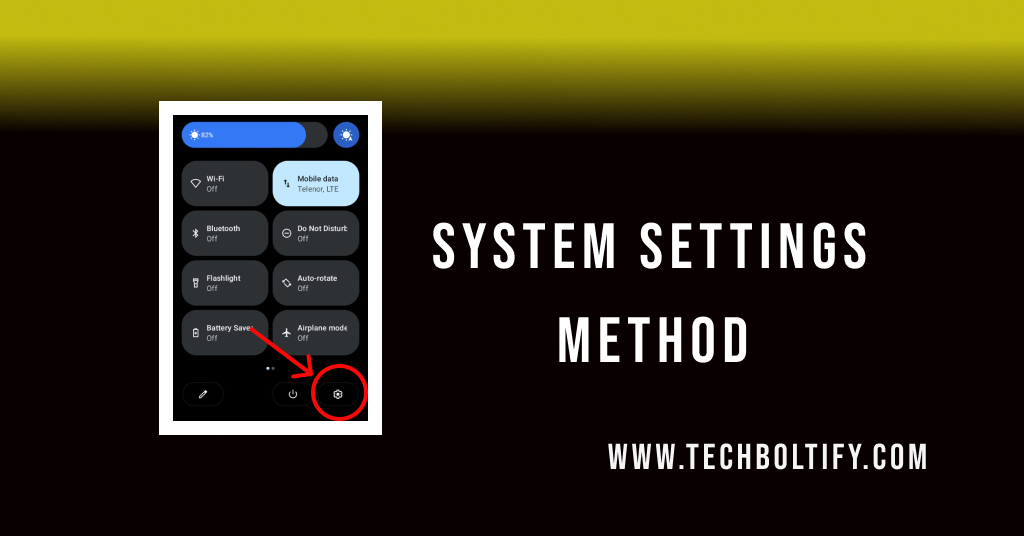Tech
What is iot Hidden Menu on my Android Phone


The IoT hidden menu is a secret set of options embedded within Android devices. These hidden options are not readily visible in your standard settings interface, but they serve a roster of robust functions that cater to the needs of advanced users and developers. To access this menu, you can either dial #0# or enter ##4636## using your phone’s dial pad. Once you’re in the hidden menu, you can test several parts of your Android phone, including USB settings, LTE settings, and more.
“The IoT Hidden Menu proves highly effective for troubleshooting various Android device issues. Typically concealed to prevent accidental changes, this menu provides access to advanced settings. However, there are instances when developers and Android users specifically seek an assessment of certain components, prompting them to utilize this hidden feature.”
If you’re curious about accessing secret features on your Android device through an IoT hidden menu, you’re in for a treat,
The IoT Hidden Menu on Android is a secret menu that allows you to test various aspects of your Android phone. It provides access to advanced settings and features that are not typically available in the device’s standard settings menu. Here’s how you can access it:
Dial Pad Method

- On Samsung devices, open the dialer app and call #0#.
- For devices from other manufacturers, enter ##4636## using the dial pad.
- Wait for the hidden menu settings to appear.
System Settings Method

- Swipe down to open the Notification bar.
- Access Quick Settings from the list.
- Hold down the Settings button (you should feel a vibration if done correctly).
The IoT Hidden Menu (also known as System UI Tuner) will now be available in your Settings menu, allowing you to customize your device12.
The IoT hidden menu is like a hidden treasure chest of advanced settings and diagnostic tools that aren’t readily visible in your standard Android settings interface. To unlock this secret menu, follow these steps:
Dial the Code:
- Open your phone’s dialler app.
- Enter the code #0# and press the call button.
- Voilà! The hidden menu should appear on your screen.
Explore the Hidden Features
Explore the Hidden Features:
Once you’re in the hidden menu, you’ll find a variety of options to explore:
LCD Test: Check your screen’s colors, touch sensitivity, and pixel display.
Vibration Test: Test your phone’s vibration motor.
Sensor Test: Verify the functionality of sensors like the accelerometer, gyroscope, and proximity sensor.
Speaker Test: Test your phone’s speakers.
Camera Test: Assess camera functionality.
Bluetooth Test: Check Bluetooth connectivity.
WiFi Test: Verify WiFi performance.
Battery Info: Get detailed battery statistics.
Service Mode: Access additional network and signal information.
Use with Caution
While it’s exciting to explore hidden features, remember that some options can affect your phone’s performance or settings. Be cautious and avoid making changes unless you know what you’re doing.
Developer Insights
Developers often use this menu for debugging and testing purposes. If you’re a developer, you’ll find valuable tools here.
Remember, the IoT hidden menu is like a backstage pass to Android’s inner workings. Enjoy your exploration, but tread carefully.
What Is the IoT Hidden Menu on Android
The IoT Hidden Menu is a special feature available on Android devices that provides access to advanced system diagnostics and testing tools. While it remains hidden from regular users, it can be quite useful for those who want to explore and tweak various settings. Here’s what you need to know:
Accessing the IoT Hidden Menu
There are two methods to access the hidden menu:
Dial Pad Method
- On Samsung devices, open the dialer app and call #0#.
- On devices from other manufacturers, enter ##4636## using the dial pad.
System Settings Method
- Swipe down to open the Notification bar.
- Access Quick Settings from the list.
Hold down the Settings button until you feel a vibration (if done correctly).
The IoT Hidden Menu (also known as the System UI Tuner) will now appear in your Settings menu.
Features of the IoT Hidden Menu
Accelerometer Sensor
Barometer: Record the pressure of the surrounding area using the built-in barometer.
Proximity Sensor: Detects when your phone is near your face during calls and turns off the screen to prevent accidental touches.
Purpose and Fun Factor: Google’s developers intentionally hid this menu as an Easter egg for curious users. It allows customization of the user interface and helps verify system functionality.
Exiting the IoT Hidden Menu: Simply press the back button to exit the menu.
Remember, while exploring the hidden menu can be exciting, be cautious not to make any unintended changes that might affect your device’s performance. Enjoy tinkering with your Android settings.
In addition, the IoT feature allows you to customize the User Interface (UI) of your device. This customization encompasses various elements, including the home screen, app information, Wi-Fi details, and more. You can perform tests across multiple categories, such as battery performance, network connectivity, Wi-Fi API status, and even toggle settings on and off. Additionally, you can run ping tests to assess network responsiveness.
Why Explore an IoT Hidden Menu
Exploring the hidden menu offers several benefits:
Customization: Users can tailor their devices beyond standard settings. This level of personalization goes beyond typical configurations.
Optimization: Accessing the hidden menu allows for performance enhancements. You can fine-tune settings and enable features that contribute to a more efficient user experience1.
Examples of IoT Devices with Hidden Menus
Let’s take a look at some noteworthy examples of IoT devices equipped with hidden menus:
Smart Thermostats: These devices often have hidden menus where you can adjust sensor sensitivity, display settings, and network configurations.
Fitness Trackers: Explore hidden menus to fine-tune tracking features, customize notifications, and optimize battery usage.
Smartphones: Some smartphone models have hidden diagnostic tools that can help identify and resolve issues.
How to Access the IoT Hidden Menu
Accessing the hidden menu varies depending on the specific device. Here are some general steps:
Research: Search online for your device model along with terms like “hidden menu” or “secret codes.
Dialer Codes: Some devices allow you to enter specific codes in the phone dialer to access hidden menus.
Button Combinations: Certain button combinations during startup or within specific apps can reveal hidden features.
Precautions and Risks
Caution: Be careful when making changes in the hidden menu. Incorrect settings could affect device functionality.
Backup: Back up your device before exploring the hidden menu.
Manufacturer Documentation: Refer to official documentation or forums for guidance.
Tips for Maximizing the IoT Hidden Menu
Explore Gradually: Take your time to understand each feature.
Document Changes: Keep track of any adjustments you make.
Share Knowledge: If you find cool features, share them with others!
Remember, the IoT hidden menu is like a treasure chest waiting to be unlocked.
Why Does IoT Exist
IoT hidden menus serve various purposes, including:
Debugging: Manufacturers include these menus to provide support technicians with tools for efficient diagnosis and troubleshooting.
Maintenance: Accessing hidden features allows fine-tuning and optimization.
Customization: Users can tailor their IoT devices to their preferences.
How to Access the IoT Hidden Menu
Access methods can vary based on the specific IoT device model.
Specific Key Combinations: Some devices require pressing specific keys simultaneously.
Codes: Entering secret codes via the device interface.
Software-Based Access Points: Using software tools or apps.
Risks and Precautions
While accessing the hidden menu is enticing, it comes with risks:
Device Harm: Modifying settings without proper knowledge can potentially harm your device.
Security Implications: Changes may compromise security.
Always proceed with caution and only make changes if you fully understand their implications.
IoT’s Hidden Features
Now, let’s explore some of the features you can find in the IoT Hidden Menu:
Accelerometer Sensor:
Gain access to the accelerometer sensor, which detects movement and orientation. Useful for checking how fast you’re going or for specific applications.
Click the “Graph” button to activate the sensor’s settings.
Barometer
Record the atmospheric pressure of your surroundings using the built-in barometer. Click on the “Barometer Selftest” option to activate it.
Proximity Sensor
Detects when your phone is near your face during calls and automatically turns off the screen to prevent accidental touches. An essential feature for call quality and usability.
Grip Sensor (Additional Feature):
Some devices may include a grip sensor that detects how tightly you’re holding your phone.
Useful for specific applications or scenarios.
Light Sensor (Additional Feature):
Measures ambient light levels and adjusts screen brightness accordingly. Helps optimize battery life and visibility in different lighting conditions
Concealed Functions: These menus harbour features beyond what you typically see in the standard user interface. They provide access to advanced settings and tools that allow for fine-tuning and customization.
Manufacturer’s Strategy: Manufacturers intentionally integrate hidden menus to cater to tech-savvy users. By unlocking these features, users can optimize and personalize their devices1.
Remember that these features may vary depending on your device model and manufacturer. Feel free to explore the IoT Hidden Menu and customize your Android experience. Not all IoT devices have a hidden menu, and the method of access may vary between manufacturers and models1. So, if you’re curious about your specific device, explore cautiously and enjoy uncovering its hidden potential.
IoT’s Touch Test
This test is typically used to verify the full-screen functionality of a device. Occasionally, the edges of a screen may be unresponsive. Follow these steps to perform the touch test:
- Click on the touch box to initiate the test.
- Place your finger on one of the corners and move it towards all the other corners.
- Ensure that all the white boxes turn green as you touch each corner.
- Next, test the screen center by tracing an X shape with your finger.
- If all the boxes turn green during the test, congratulations! Your mobile touch functionality is in good condition.
How to Enable Android Hidden Settings
Here are a few ways to access them:
Dialler Codes: You can use dialler codes (also known as USSD and MMI codes) to access hidden settings on your Android phone. Open your phone’s dialler app and enter the following codes:
Access Phone Stats: Dial ##4636## to open the testing menu. From there, you can check your phone information, usage statistics, Wi-Fi details, and even find your IMEI number.
IMEI Number Shortcut: If you want to quickly find your IMEI number, just dial #06#. Specific Absorption Rate (SAR): To check your phone’s SAR level (the radiofrequency energy absorbed by your body), dial #07#. This will retrieve the regulatory label with relevant SAR data.
Google Play Diagnostics: If you need to run Google Play diagnostics, enter ##426##.
Google Settings App (Android 8.0 and above)
- Open your phone’s default Settings app.
- Scroll down and tap on “Google.”
- Here, you’ll find various options to tweak settings according to your needs1.
Quick Settings Panel
- Swipe down from the top of your screen to open the quick settings panel.
- Tap the edit button (usually represented by a pencil icon).
- Scroll down to the bottom of the list and tap “More settings.” From there, you can add hidden settings to your quick settings panel.
Some of these settings can affect your phone’s functionality, so use them with caution. Enjoy exploring the hidden features.
Benefits of IoT Hidden Menu
The IoT Hidden Menu on Android offers several benefits for advanced users and developers. Let’s explore them:
Customization and Testing
UI Customization: You can tweak various aspects of your device’s user interface (UI) that are not accessible through standard settings. Change system animations, enable or disable features, and personalize your phone.
System Testing: Use the hidden menu to check hardware components, sensors, and system functions. For example, you can test the accelerometer, barometer, proximity sensor, and more.
Advanced Network Information
Cellular Signal Strength: View detailed information about your cellular network, including signal strength, network type (3G, 4G, etc.), and neighbouring cell towers.
Wi-Fi Details: Access additional Wi-Fi settings, such as channel information and signal strength.
Battery Optimization
Battery Stats: Monitor battery usage and identify power-hungry apps.
Battery Saver Mode: Enable or disable battery saver mode directly from the hidden menu.
Diagnostic Tools
Logcat: Developers can access system logs for debugging purposes.
IMEI and Device Information: Retrieve your device’s IMEI number and other essential details.
Network Mode Selection:
Choose between different network modes (e.g., 2G, 3G, 4G, LTE) to optimize data speed and battery life.
In Conclusion
The IoT Hidden Menu is an app package that helps you customize your device’s user interface (UI) and check whether your system is functioning well. Google’s developers intentionally hid it as a fun treat for users. On most phones, this menu is called the System UI Tuner. It is a secret set of options embedded within Android devices. These hidden menus are not readily visible in your standard settings interface, but they serve a roster of robust functions that cater to the needs of advanced users and developers
Tech
How To Bridge Front-End Design And Backend Functionality With Smarter API Strategy
Introduction: Building More Than Just Screens
We’ve all seen apps that look sharp but crumble the moment users push beyond the basics. A flawless interface without strong connections underneath is like a bridge built for looks but not for weight. That’s why APIs sit at the heart of modern software. They don’t just move data; they set the rules for how design and logic cooperate. When APIs are clear, tested, and secure, the front-end feels smooth, and the backend stays reliable.
The reality is that designing those connections isn’t just “coding.” It’s product thinking. Developers have to consider user flows, performance, and future scale. It’s about more than endpoints; it’s about creating a system that’s flexible yet stable. That mindset also means knowing when to bring in a full-stack team that already has the tools, patterns, and experience to move fast without cutting corners.
Here’s where you should check Uruit’s website. By focusing on robust API strategy and integration, teams gain the edge to deliver features user’s trust. In this article, we’ll unpack how to think like a product engineer, why APIs are the real bridge between design and functionality, and when it makes sense to call in expert support for secure, scalable development.
How To Define An API Strategy That Supports Product Goals
You need an API plan tied to what the product must do. Start with user journeys and map data needs. Keep endpoints small and predictable. Use versioning from day one so changes don’t break clients. Document behavior clearly and keep examples short. Design for errors — clients will expect consistent messages and codes. Build simple contracts that both front-end and backend teams agree on. Run small integration tests that mimic real flows, not just happy paths. Automate tests and include them in CI. Keep latency in mind; slow APIs kill UX. Think about security early: auth, rate limits, and input checks. Monitor the API in production and set alerts for key failures. Iterate the API based on real use, not guesses. Keep backward compatibility where possible. Make the API easy to mock for front-end developers. Celebrate small wins when a new endpoint behaves as promised.
- Map user journeys to API endpoints.
- Use semantic versioning for breaking changes.
- Provide simple, copy-paste examples for developers.
- Automate integration tests in CI.
- Monitor response times and error rates.
What To Do When Front-End and Backend Teams Don’t Speak the Same Language
It happens. Designers think in pixels, engineers think in data. Your job is to make a shared language. Start by writing small API contracts in plain text. Run a short workshop to align on fields, types, and error handling. Give front-end teams mocked endpoints to work against while the backend is built. Use contract tests to ensure the real API matches the mock. Keep communication frequent and focused — short syncs beat long meetings. Share acceptance criteria for features in user-story form. Track integration issues in a single list so nothing gets lost. If you find repeated mismatches, freeze the contract and iterate carefully. Teach both teams basic testing so they can verify work quickly. Keep the feedback loop tight and friendly; blame only the problem, not people.
- Create plain-language API contracts.
- Provide mocked endpoints for front-end use.
- Contract tests between teams.
- Hold short, recurring integration syncs.
- Keep a single backlog for integration bugs.
Why You Should Think Like a Product Engineer, Not Just A Coder
Thinking like a product engineer changes priorities. You care about outcomes: conversion, help clicks, retention. That shifts API choices — you favor reliability and clear errors over fancy features. You design endpoints for real flows, not theoretical ones. You measure impact: did a change reduce load time or drop errors? You plan rollouts that let you test with a small cohort first. You treat security, observability, and recoverability as product features. You ask hard questions: what happens if this service fails? How will the UI show partial data? You choose trade-offs that help users, not just satisfy a design spec. That mindset also tells you when to hire outside help: when speed, scale, or compliance exceeds your team’s current reach. A partner can bring patterns, reusable components, and a proven process to get you shipping faster with less risk.
- Prioritize outcomes over features.
- Measure the user impact of API changes.
- Treat observability and recovery as product features.
- Plan gradual rollouts and feature flags.
- Know when to add external expertise.
How We Help and What to Do Next
We stand with teams that want fewer surprises and faster launches. We help define API strategy, write clear contracts, and build secure, testable endpoints that front-end teams can rely on. We also mentor teams to run their own contract tests and monitoring. If you want a quick start, map one critical user flow, and we’ll help you design the API contract for it. If you prefer to scale, we can join as an extended team and help ship several flows in parallel. We stick to plain language, measurable goals, and steady progress.
- Pick one key user flow to stabilize first.
- Create a minimal API contract and mock it.
- Add contract tests and CI guards.
- Monitor once live and iterate weekly.
- Consider partnering for larger-scale or compliance needs.
Ready To Move Forward?
We’re ready to work with you to make design and engineering speak the same language. Let’s focus on one flow, make it reliable, and then expand. You’ll get fewer regressions, faster sprints, and happier users. If you want to reduce risk and ship with confidence, reach out, and we’ll map the first steps together.
Tech
Which SEO Services Are Actually Worth Outsourcing? Let’s Talk Real-World Wins
Okay, raise your hand if you thought SEO just meant stuffing keywords into blog posts and calling it a day. (Don’t worry, we’ve all been there.) Running a business comes with enough hats already, and when it comes to digital stuff, there’s only so much you can do on your own before your brain starts melting. The world of SEO moves quick, gets technical fast, and—honestly—a lot of it’s best left to the pros. Not everything, but definitely more than people expect. So, let’s go through a few of those SEO services you might want to hand off if you’re looking to get found by the right folks, minus the headaches.
Technical SEO—More Than Just Fancy Talk
If you’ve ever seen a message saying your website’s “not secure” or it takes ages to load, yeah, that’s technical SEO waving a big red flag. This stuff lives under the hood: page speed, mobile-friendliness, fixing broken links, and getting those little schema markup things in place so search engines understand what the heck your pages are about.
You could spend hours (days) learning this on YouTube or DIY blogs, but hiring a specialist—someone who does this all day—saves you a load of stress and guesswork. Sites like Search Engine Journal dig into why outsourcing makes sense, and honestly, after one too many late-night plugin disasters, I’m convinced.
Content Writing and On-Page Optimization (Because Words Matter)
Let’s not dance around it: great content still rules. But search-friendly content is a different beast. It needs to hit the right length, work in keywords naturally, answer genuine questions, and actually keep visitors hooked. Outsourcing writing, especially to someone who actually cares about your brand’s tone, is worth it for most of us.
On-page SEO, which is tweaking all those little details like titles, descriptions, internal links, and image alt text, is a time-eater. It’s simple once you get the hang of it, but when you’re trying to grow, outsourcing makes the most sense.
Link Building—Trickier Than It Looks
Here’s where things get a bit spicy. Backlinks are essential, but earning good ones (not spammy or shady stuff) takes relationship-building, tons of outreach, and real patience. You can spend all month sending emails hoping someone will give your guide a shout-out, or you can just hire folks with connections and a process. Just watch out for anyone promising “hundreds of links for dirt cheap”—that’s usually a shortcut to trouble.
Local SEO—Getting Seen in Your Own Backyard
Ever tried showing up for “pizza near me” only to find yourself on page 7? Local SEO isn’t magic, but it takes a special touch: optimizing your Google Business Profile, gathering reviews, and making sure your info matches everywhere. It’s honestly a job in itself, and most small teams find it way easier to have a local SEO pro jump in a few hours a month.
Reporting and Analytics—Don’t Go Blind
Last, don’t skip out on real reporting. If nobody’s tracking what’s working—and what’s not—you’re just flying blind. Outsourced SEO pros come armed with tools and real insights, so you can see if your money’s going somewhere or just swirling down the drain.
Wrapping Up—Be Realistic, Outsource Smarter
You’re good at what you do, but SEO is more like ten jobs rolled into one. Outsource the parts that zap your time or make your brain itch, and keep what you enjoy. Focus on the wins (more leads, higher rankings, fewer headaches), and watch your business get the attention it deserves.
Tech
White-Label SEO: Building Scalable Digital Marketing Partnerships
Table of Contents
- What Is White-Label SEO?
- Why Digital Agencies Choose White-Label Solutions
- How White-Label SEO Works in Practice
- Benefits for Small and Mid-Sized Agencies
- Risk Management and Quality Assurance
- White-Label SEO and Client Retention
- What to Look for in a White-Label SEO Partner
- Future Trends in White-Label SEO
What Is White-Label SEO?
White-label SEO refers to a business arrangement where an agency partners with a third-party provider to deliver SEO services under the agency’s own brand. Unlike traditional outsourcing, where the client may be aware of third-party involvement, white-label models ensure the service provider remains invisible to the end client. The agency retains control over client communication and branding while benefiting from the expertise and tools of seasoned SEO professionals.
This structure allows agencies to offer complete SEO solutions without needing deep in-house expertise, staffing, or technology. For those looking to deliver robust results while maintaining their branding, leveraging an established provider such as SEO white label by Vazoola is a popular route. As demand for scalable and specialized SEO services grows, white-label partnerships have become a cornerstone for forward-thinking digital marketing agencies.
Why Digital Agencies Choose White-Label Solutions
Agencies of all sizes frequently encounter resource constraints, particularly as clients ask for increasingly sophisticated services. Building an advanced SEO department in-house can be cost-prohibitive, requiring hiring, training, and constant adaptation to search engine algorithm changes. White-label solutions are attractive because they enable agencies to offer first-rate SEO without prohibitive investments.
Additionally, as the digital landscape evolves, clients seek integrated digital marketing strategies instead of disconnected services. With white-label SEO, agencies can rapidly expand their offerings, supporting their growth strategies while capturing a larger market share. This flexibility allows consultancies and digital agencies to remain competitive as demands for comprehensive solutions intensify.

How White-Label SEO Works in Practice
A typical white-label SEO partnership starts with thorough onboarding and aligning goals and processes between the agency and the provider. The agency submits client data and campaign objectives, while the provider crafts a tailored SEO strategy and implementation plan. Once campaigns are underway, the agency oversees communication with its clients, while the provider handles the technical execution—keyword research, link building, technical audits, or content creation.
White-label SEO providers support streamlined communication through client dashboards, branded reports, and regular performance updates. Consistent reporting helps agencies build trust and credibility with their clients without revealing the third-party provider. Workflow automation and transparency are central to success, as illustrated in case studies where agencies have seamlessly scaled from a handful to dozens of clients due to repeatable, managed processes. For further insights, consider Moz’s SEO Guide, a comprehensive resource on industry-accepted best practices.
Benefits for Small and Mid-Sized Agencies
White-label SEO is often a game-changer for small and mid-sized agencies because it equalizes the playing field with larger competitors. These agencies can deliver enterprise-grade SEO services by tapping into top-tier talent and technology while maintaining personalized client relationships. This versatility helps attract and retain clients who might otherwise gravitate toward major digital marketing firms.
Another key advantage is the ability to focus internal teams on their strengths, whether that’s account management, creative work, or strategy. Rather than spreading resources thin, agencies can direct their energy where it adds the most value. By outsourcing technical SEO, they reduce overhead and avoid the risks of hiring, training, and turnover.
Risk Management and Quality Assurance
A significant challenge in white-label SEO is ensuring consistent communication, maintaining transparency, and delivering dependable results. Agencies should adopt robust QA frameworks to monitor campaign progress, verify deliverables, and address issues promptly. Scheduled performance reviews, auditing tools, and transparent project management processes are essential to quality assurance.
To mitigate risks, agencies should establish transparent reporting systems and agree on milestones and metrics upfront. Following the guidance of established leaders like Moz can help agencies set clear expectations and implement best practices in all aspects of SEO campaign delivery.
White-Label SEO and Client Retention
Strong white-label partnerships foster long-term client retention. Agencies can consistently deliver value through outcome-focused campaigns—whether improving rankings, increasing organic traffic, or driving conversions. The ability to tap into a partner’s expertise and resources means agencies are better equipped to meet evolving client expectations and deliver measurable results over time.
The seamless integration of white-label services also allows agencies to provide end-to-end digital marketing solutions, reducing the need for clients to seek alternative providers.
What to Look for in a White-Label SEO Partner
Choosing the right white-label SEO partner is crucial. Agencies should prioritize experience, reputation, transparent processes, and technical scalability. A strong partner openly shares methodologies, provides real-time support, and can accommodate a growing client base without sacrificing quality or compliance.
Be wary of partners who promise rapid results without clear strategies, offer generic services, or lack documented reporting and quality control processes. Key questions to ask include: What is your approach to link building? How do you handle reporting and communication? What QA measures are in place? Review insights from trusted white-label news sources to compare industry-leading providers and inform your vetting process.
Future Trends in White-Label SEO
Automation, AI integration, and advanced analytics define the future of white-label SEO. Emerging tech platforms help streamline keyword research, content optimization, and reporting, delivering greater efficiency for agencies and their clients. As client expectations rise, providers focus on more sophisticated dashboards, granular analytics, and proactive strategic support.
Similarly, the partnership model is evolving. Agencies and white-label providers are moving toward deeper collaborations, with joint innovation and tailored solutions playing an increasing role. Agencies prioritizing adaptability and choosing forward-thinking partners will be best positioned to thrive in the changing landscape.
-
Tech1 year ago
AI and Freight Management
-

 Tech2 years ago
Tech2 years agoLPPe Service Android App and its Functions – How to Remove it
-

 Tech1 year ago
Tech1 year agoWhat is a Permission Controller – Control Manager Notifications
-

 Tech2 years ago
Tech2 years agoWhat is Device Keystring App On Android
-

 Tech2 years ago
Tech2 years agoWhat is Carrier Hub – How to Resolve Processing Requests Issues
-

 Tech2 years ago
Tech2 years agoWhat is Summit IMS Service – How to Stop Syncing on Your Android Device
-

 Tech2 years ago
Tech2 years agoMeta App Manager – What is Meta App Installer
-

 Tech2 years ago
Tech2 years agoWhat is Cameralyzer Samsung – How to Fix or Uninstall Cameralyzer on Android

